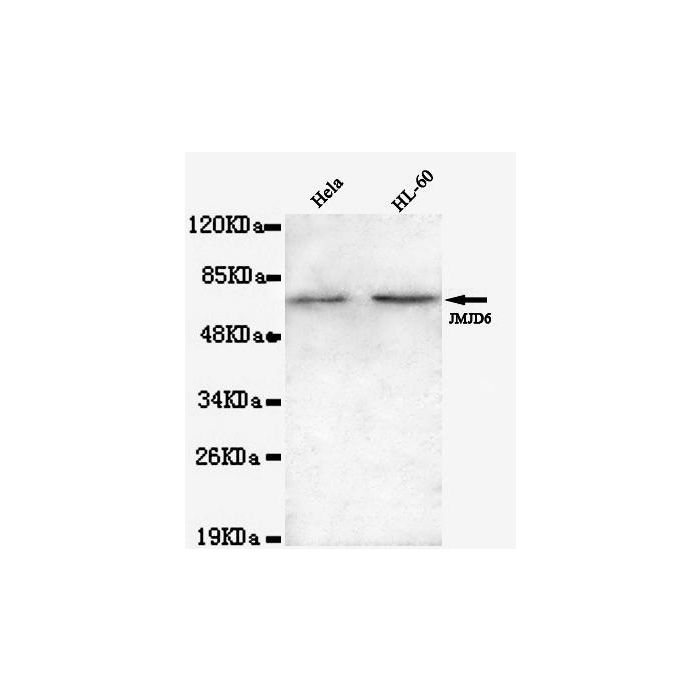JMJD6 (N-terminus) (clone ), anti-human
€388.00
In stock
SKU
MB0100
Background:
Cells undergoing apoptosis lose the asymmetry of plasma membrane phospholipids, and phosphatidylserine is exposed on the outer surface of the membrane. The phosphatidylserine receptor (PSR) specifically recognizes phosphatidylserine and this binding triggers the phagocytosis of apoptotic cells by either macrophages or dendritic cells. PSR is expressed on the surface of macrophages, fibroblasts, and epithelial cells, and it has been detected in high levels in heart, skeletal muscle, and kidney tissues and is extensively glycosylated. The mammalian phosphatidylserine receptor displays significant homology to Caenorhabditis elegans and Drosophila melanogaster proteins, which suggests that PSR has been conserved throughout phylogeny.
Alternative Name:
PSR, PTDSR, PTDSR1, KIAA0585, jumonji domain containing 6, Lysyl-hydroxylase JMJD6, Phosphatidylserine receptor, PTDSR, KIAA0585, Histone arginine demethylase JMJD6, JmjC domain-containing protein 6, PSR, Peptide-lysine 5-dioxygenase JMJD6, Protein PTDSR
Application Dilution: WB: 1:1000, ICC: 1:100~200
Specificity: This antibody detects endogenous levels of JMJD6 and does not cross-react with related proteins
Immunogen:
Synthetic peptide, corresponding to the N-terminus of Human JMJD6.
MW: Predicted band size: 46KDa , Observed band size: 62KDa
Swis Prot.: Q6NYC1
Purification & Purity:
The antibody was affinity-purified from mouse ascites by affinity-chromatography using epitope-specific immunogen and the purity is > 95% (by SDS-PAGE).
Format:
Purified mouse monoclonal in buffer containing 0.1M Tris-Glycine (pH 7.4, 150 mM NaCl) with 0.2% sodium azide, 50%,glycerol
Storage:
Store at 4°C short term. Aliquot and store at -20°C long term. Avoid freeze-thaw cycles.
For research use only, not for use in diagnostic procedure.
Cells undergoing apoptosis lose the asymmetry of plasma membrane phospholipids, and phosphatidylserine is exposed on the outer surface of the membrane. The phosphatidylserine receptor (PSR) specifically recognizes phosphatidylserine and this binding triggers the phagocytosis of apoptotic cells by either macrophages or dendritic cells. PSR is expressed on the surface of macrophages, fibroblasts, and epithelial cells, and it has been detected in high levels in heart, skeletal muscle, and kidney tissues and is extensively glycosylated. The mammalian phosphatidylserine receptor displays significant homology to Caenorhabditis elegans and Drosophila melanogaster proteins, which suggests that PSR has been conserved throughout phylogeny.
Alternative Name:
PSR, PTDSR, PTDSR1, KIAA0585, jumonji domain containing 6, Lysyl-hydroxylase JMJD6, Phosphatidylserine receptor, PTDSR, KIAA0585, Histone arginine demethylase JMJD6, JmjC domain-containing protein 6, PSR, Peptide-lysine 5-dioxygenase JMJD6, Protein PTDSR
Application Dilution: WB: 1:1000, ICC: 1:100~200
Specificity: This antibody detects endogenous levels of JMJD6 and does not cross-react with related proteins
Immunogen:
Synthetic peptide, corresponding to the N-terminus of Human JMJD6.
MW: Predicted band size: 46KDa , Observed band size: 62KDa
Swis Prot.: Q6NYC1
Purification & Purity:
The antibody was affinity-purified from mouse ascites by affinity-chromatography using epitope-specific immunogen and the purity is > 95% (by SDS-PAGE).
Format:
Purified mouse monoclonal in buffer containing 0.1M Tris-Glycine (pH 7.4, 150 mM NaCl) with 0.2% sodium azide, 50%,glycerol
Storage:
Store at 4°C short term. Aliquot and store at -20°C long term. Avoid freeze-thaw cycles.
For research use only, not for use in diagnostic procedure.
| Is Featured? | No |
|---|
Write Your Own Review

